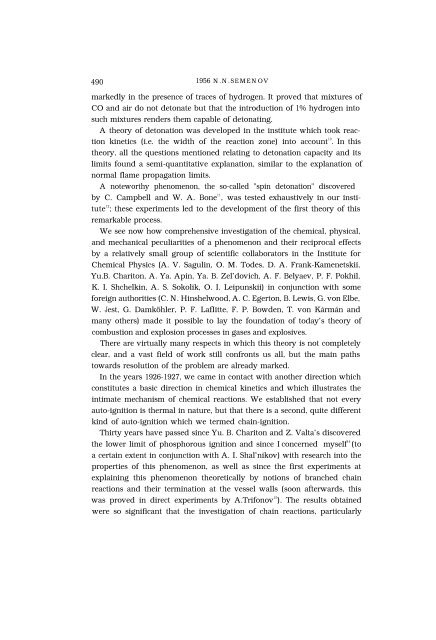Nikolai N. Semenov - Nobel Lecture - Nobelprize.org
Nikolai N. Semenov - Nobel Lecture - Nobelprize.org
Nikolai N. Semenov - Nobel Lecture - Nobelprize.org
Create successful ePaper yourself
Turn your PDF publications into a flip-book with our unique Google optimized e-Paper software.
490 1956 N.N.SEMENOV<br />
markedly in the presence of traces of hydrogen. It proved that mixtures of<br />
CO and air do not detonate but that the introduction of 1% hydrogen into<br />
such mixtures renders them capable of detonating.<br />
A theory of detonation was developed in the institute which took reaction<br />
kinetics (i.e. the width of the reaction zone) into account 10 . In this<br />
theory, all the questions mentioned relating to detonation capacity and its<br />
limits found a semi-quantitative explanation, similar to the explanation of<br />
normal flame propagation limits.<br />
A noteworthy phenomenon, the so-called "spin detonation" discovered<br />
by C. Campbell and W. A. Bone 11 , was tested exhaustively in our institute<br />
12 ; these experiments led to the development of the first theory of this<br />
remarkable process.<br />
We see now how comprehensive investigation of the chemical, physical,<br />
and mechanical peculiarities of a phenomenon and their reciprocal effects<br />
by a relatively small group of scientific collaborators in the Institute for<br />
Chemical Physics (A. V. Sagulin, O. M. Todes, D. A. Frank-Kamenetskii,<br />
Yu.B. Chariton, A. Ya. Apin, Ya. B. Zel’dovich, A. F. Belyaev, P. F. Pokhil,<br />
K. I. Shchelkin, A. S. Sokolik, O. I. Leipunskii) in conjunction with some<br />
foreign authorities (C. N. Hinshelwood, A. C. Egerton, B. Lewis, G. von Elbe,<br />
W. Jest, G. Damköhler, P. F. LafIitte, F. P. Bowden, T. von Kármán and<br />
many others) made it possible to lay the foundation of today’s theory of<br />
combustion and explosion processes in gases and explosives.<br />
There are virtually many respects in which this theory is not completely<br />
clear, and a vast field of work still confronts us all, but the main paths<br />
towards resolution of the problem are already marked.<br />
In the years 1926-1927, we came in contact with another direction which<br />
constitutes a basic direction in chemical kinetics and which illustrates the<br />
intimate mechanism of chemical reactions. We established that not every<br />
auto-ignition is thermal in nature, but that there is a second, quite different<br />
kind of auto-ignition which we termed chain-ignition.<br />
Thirty years have passed since Yu. B. Chariton and Z. Valta’s discovered<br />
the lower limit of phosphorous ignition and since I concerned myself 14 (to<br />
a certain extent in conjunction with A. I. Shal’nikov) with research into the<br />
properties of this phenomenon, as well as since the first experiments at<br />
explaining this phenomenon theoretically by notions of branched chain<br />
reactions and their termination at the vessel walls (soon afterwards, this<br />
was proved in direct experiments by A.Trifonov 15 ). The results obtained<br />
were so significant that the investigation of chain reactions, particularly
















